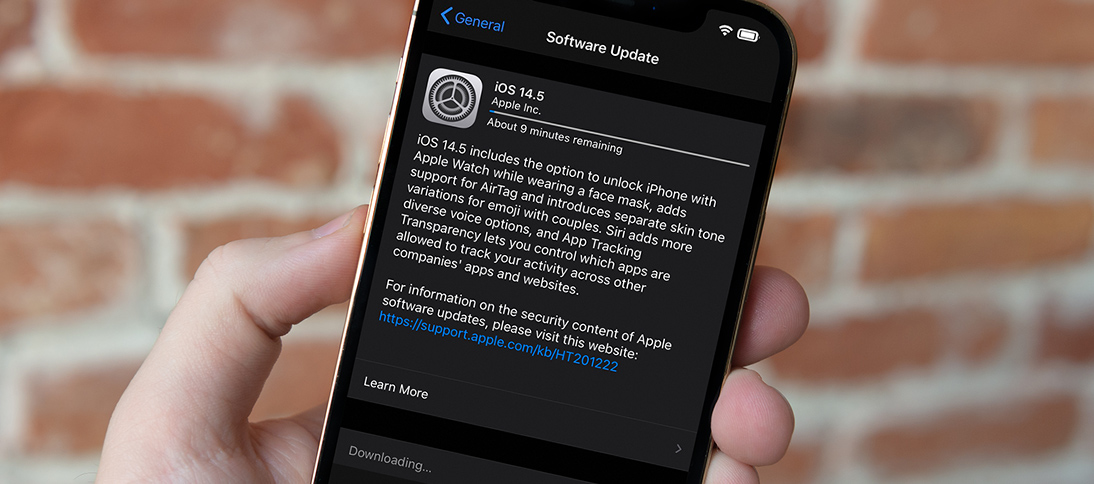With the rollout of iOS14.5 to the general public, Apple claims to be taking a stand for your digital privacy—but it means much more than just that to a lot of stakeholders, including Facebook.
If you haven’t been following the story, iOS 14.5 brings with it a host of privacy changes that let users prevent apps from tracking them around the web on Apple devices.
Facebook, along with some other third parties, have been raging against this update since it was announced last year. They claim that Apple will use the data they collect on individuals helps small businesses to advertise more efficiently, while also highlighting the fact that some ‘free’ publications and apps can only exist by tracking user data and selling it on to advertisers.
Privacy is the new digital battleground. Everyone has a stake in this fight—including you, both as an individual and as a marketer. It’s too early to predict the fallout, but your site traffic and advertising budgets could be disrupted as a result of the rumble.
Here’s the rundown:
What is Apple doing with these privacy updates and why are they doing it?
Apple’s iOS devices, when updated to the latest version, are going to start asking users if they want to let their apps track them instead of allowing it by default. Users will have finer control over what data can be tracked by apps, if any, and will be asked for their preferences the first time each app is opened.
The fear within marketing is that most users will not agree to be tracked. Most digital marketing channels won’t feel much of a change, but digital advertising relies on user data to ensure ads only reach those most likely to be influenced.
Apple’s new brand focus is all about privacy, hence why they’re pushing this change so intently. They believe a major revolution is needed in how tech giants handle our personal data. If you’ve seen The Social Dilemma, you might find yourself in agreement.
How does Facebook feel about this new Apple position?
Facebook is very angry. They’re so angry they took out full-page ads in print about it:
It is immensely challenging to feel any kind of pathos for Facebook in the year 2021, but their ad isn’t completely devoid of truth.
Facebook isn’t wrong when it claims that small businesses have increased their use of personalized advertising on social media platforms during the pandemic.
It’s also true that many companies rely on Facebook’s tracking data to target you with those personalized ads, a service that generated Facebook $84bn in revenue in 2020.
If Facebook can’t keep tracking insane amounts of user data in as much granularity, ad performance on the platform is likely to drop, and brands are likely to withdraw their funding.
That said, Facebook is also in the news for something else at the moment: a major lawsuit claiming that Facebook intentionally refused to make changes to a misleading advertising metric because executives were worried advertisers would lower budgets if they knew the truth.
Facebook advertising can be a powerful tool when used correctly, but since the numbers marketers are presented with can be addictive and not entirely accurate, we find it hard to see them as a force for the benefit of any other business than their own.
How does this affect digital marketing?
While this sounds like a sweeping change, your website analytics and tagging shouldn’t need to change, since this update primarily affects mobile apps and the amount of data they’re allowed to track and read.
However, your digital advertising program will have some hoops to jump through. Make doubly sure you’re up-to-date with the latest changes that Facebook has made to their attribution systems, how they deliver data, and how their ability to target users might be changing, as the systems have changed dramatically to adjust to Apple’s aggression.
People on iOS may be harder to track. How many of your customers might this affect?
In some US states like New York, Alaska, and Louisiana, this 2018 study estimates that over 70% of residents use iOS devices. It’s impossible to say how many of them will decline tracking, but the public perception of data and ‘tracking’ is one of fear and mistrust. Since Apple is outright asking users ‘do you want this app to track you,’ we’re betting most people will reflexively hit ‘no’.
If you want to know exactly how many of your site or app users are on iOS and you have Google Analytics set up, go to the ‘Audience’ report, then ‘Technology’, then ‘Device.’
What will happen as a result of this?
Facebook is about to become a less attractive option for advertising, although the same is true for almost all ad platforms. Facebook was simply the greatest scraper of your personal data, and that trough is drying up.
But in taking away that source of monetization for apps and websites, what will happen to the free sites—ranging from news publications to YouTube—that rely on ad placement for funding?
There’s no time for speculation; the cats out of the bag as of April 25th, 2021, and we’ll be keeping a close eye on the situation as it plays out.
What else is happening to data privacy?
In 2022, Google Chrome has phased out third-party cookies, just like competitors Safari (as part of Apple’s privacy push) and Firefox have done. We’ll keep you updated on how the change will affect the industry and how you can avoid any nasty surprises in your marketing closer to the time.
That’s what we know about the impact of Apple iOS14.5 for now. There will be more disruption as the full extent of the consequences unfold, but it’s for the sake of privacy, ease of regulation, and protection for the consumer — we say bring it on.
What you can do about it
In short, a whole bunch of stuff is happening and no one has a clear idea what the future might hold. What can you do to avoid the fallout?
Caring for your customers is key
With advertising performance facing uncertainty, we have a very simple message: own your relationship(s).
Give your customers a reason to enter into and maintain a relationship with your brand. Day in, day out. An audience built through advertising is fickle, dependent on the algorithms of ad platforms, and it’s expensive. It’s also potentially misleading—can you say for sure that people are seeing and engaging with what you’re paying for, regardless of what Facebook’s ad manager tells you?
On the other hand, an audience that your brand has earned is more likely to stick with you. Build loyalty by delivering engaging and insightful content, exclusive promotions, and an excellent digital experience overall, and you’ll have an audience that will convert effectively all-year-round—and you don’t have to pay to keep them close.
Invest in Email Marketing and build a community
A recent article from MediaPost states that 98% of surveyed retail brands are investing more in email marketing in 2021. Email marketing ROI has been astronomical for a long time, and we remind our clients of that all the time. By keeping a well-maintained database of email contacts, not only can you control the relationship and speak to people one-on-one to build brand trust and loyalty, but you can also improve your visibility into the demographics of your audience.
Simply asking customers for their information might surprise you; they will actually do it if you give them a reason to, whether that’s a discount or other incentive or simply the promise of an improved service in the future.
In maintaining and regularly engaging with your database community, you continue to have a composite of those most likely to engage with your brand. Most importantly, you have the demographic data of people who actually wanted to give it to you; your brand’s most loyal customers, making it easier to find even more of them.
And speaking of respecting your customer’s time…
Make Great Content to Build Great Customer Relationships
Facebook Ads have been an excellent way of getting users to your site, but have been much less effective at keeping them or getting them to return. A steady, smaller stream of traffic that values every resource you provide them could be much more effective for your business than waves of users seeing your site for the first time and then leaving without visiting more than one page.
Make your site or app a genuinely useful service by providing excellent educational content. Focus on outdoing your competitors in terms of quality, with better writing and visuals, or even by investing in creating video (or podcast) content. Get creative.
With advertising losing some of its targeting granularity, the best way to get people within specific demographics to your site is to create content that serves what they’re actually looking for online. Be in front of them in their moment of need.
Again, choose quality over quantity, and don’t be concerned that quality has to mean expensive and superficial. Make content that is genuinely relevant, then optimize that content for SEO to get customers from search channels. If they leave your site having learned or gained something, you can bet they’ll be more likely to come back in the future. (Plus, you can then repurpose that content and send it to your customers via email!)
Social media still works without ads
Remember a time before Facebook was a pay-to-play platform? Brands that don’t spend money on Facebook ads have their reach throttled, so it can be easy to forget that Facebook, Instagram, et al, are still social media platforms, not just giant advertising machines, and can be used by marketers efficiently and effectively.
While the growth of your social media profiles will be limited if you’re not splashing the cash, you can still have a presence that provides a great experience with your brand in front of a huge potential audience. Post frequently, use unique and attractive visuals, provide useful information, and respond to every comment and message to get in front of the most eyes in the most genuine way.
Over time, you can build strong relationships with your customers that stretch far beyond what is possible through advertising alone. Instead of investing in a fickle flow of traffic from advertising, invest in your marketing team and in a holistic, top-quality digital ecosystem that provides convenience and quality for your users. The best marketing programs use every avenue available to them with one consistent, quality approach.
Of course, building a top-notch, 360-degree digital marketing program that covers every relevant channel for your business isn’t easy, quick, or even cheap.
You could muddle through, alone, figuring out workflows, tools, and tactics for the very first time, or you could reach out and ask the experts.
Want to know more? We’re offering blog readers a free marketing consultation! We love talking to companies that are ready to make the most of what digital marketing has to offer.

:no_upscale()/cdn.vox-cdn.com/uploads/chorus_asset/file/22457234/Screen_Shot_2021_04_20_at_12.36.05_PM.png)



